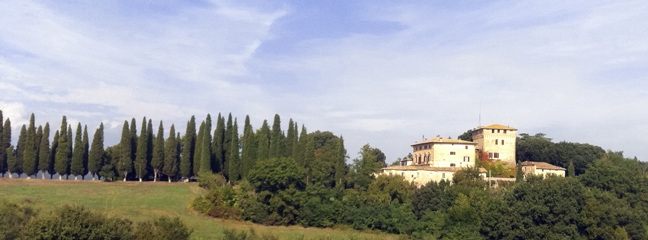War in Val d’Orcia: An Italian War Diary, 1943-1944 by Iris Origo
Reviewed by Rick Price, Ph.D.In southern Tuscany, just south of Siena, is the Valley of the Orcia River, the “Val d’Orcia” in Italian. The photo at the top of the page shows the austere and romantic landscape as seen from one of our hotels in the area. It was in this region, not far from Montepulciano and Pienza, that Iris Origo, an American woman married to an Italian aristocrat, spent 1943 and 1944 living on the family estate at La Foce. Here, Origo, her family, various hired hands, their families and as many as fifty-seven farmers (and their extended families) occupying the farms on the family estate across seven thousand acres witnessed the collapse of Mussolini’s government, the retreat of the German army, and the eventual allied victory during World War II.
Iris Cutting was born to an American father and Irish mother in 1902. Her father died in 1910 but the estate he left his widow allowed Iris to grow up living amid expatriate Americans and British in Italy amid both fine society and fine Renaissance villas. We learn from Denis Mack Smith, eminent British historian of Italian history, in his introduction to War in Val d’Orcia that Iris’s mother chose Italy because of the wish of her husband that Iris be “brought up in France or Italy or at all events ‘somewhere where she does not belong’ in order to become cosmopolitan and free from any narrow patriotism.” Iris married Antonio Origo, illegitimate son of Marchese Clemente Origo, in 1924 and became fully integrated into this wealthy Italian family. Iris Origo is remarkable for the ease with which she documents, almost daily, the progress of the war in Italy through her diary. Her philanthropic upbringing led her and her husband to take in some twenty-three refugee children from northern Italian cities that were bombed during the hostilities. She was pregnant with her third child when her narrative begins on January 30, 1943. By this time Mussolini’s dictatorship was collapsing and Italy was governed primarily by Hitler. The allied armies were in North Africa and by July that year invaded Sicily. It was a full year (June 1944) before the allies made their way up the boot of Italy to Val d’Orcia. From her vantage point in Southern Tuscany Iris Origo stole a little time almost every day to write her descriptions of what was happening around her. Her entries are precise, concise, wonderfully descriptive of daily life and often speculative when news was hard to get:
And so it goes. . . Over the course of the next year, Iris describes the War in Italy as the allies slowly move north from Naples, the Germans retreat, young Italian conscripts flee the draft as British prisoners of war are billeted in a nearby castle, and the local population is caught in the midst of this great conflict:
Then, as the Germans begin to retreat northward:
I mentioned above that Iris Origo was a remarkable woman. Indeed, each entry in the diary was written once, in the heat of the moment, based on personal observation and with the knowledge she had at the time, perhaps gone over once for grammar, but never edited or “corrected.” As she writes in her introduction, “on re-reading, I have refrained from ‘touching up’ the photograph, from changing the color of events in the light of subsequent knowledge” when, at the end of the conflict she had more complete information and might have been tempted to “fill in the details.” War narratives are often hard to read or to understand. But for those of us who have never experienced war or its aftermath firsthand, they are a critical part of our education. How can we understand the horrors of war, their impact on local populations, or the response of children without first-hand accounts such as this one? If you are headed to Tuscany you might just want to let Iris Origo be your guide to southern Tuscany. Read more about Iris Origo on Wikipedia or in Caroline Moorehead’s biography IRIS ORIGO: Marchesa of Val d’Orcia, reviewed here in the New York Times. Here are a couple ExperiencePlus! tours that feature bicycling in the Val d’Orcia: We also offer self-guided tours in the area through www.BikeRentalsPlus.com, for those whose schedule doesn’t fit our guided tour offerings:
|
War in Val d’Orcia by Iris Origo



 Origo’s book War in Val d’Orcia is, perhaps, one of the only eye witness accounts of the War in Italy behind the battle lines written by a woman. Anyone traveling to this area on a bicycle tour or otherwise should read this narrative. What a fascinating story Origo weaves through her daily diary entries about this period of World War II in Italy. And what a fascinating woman Iris Origo is.
Origo’s book War in Val d’Orcia is, perhaps, one of the only eye witness accounts of the War in Italy behind the battle lines written by a woman. Anyone traveling to this area on a bicycle tour or otherwise should read this narrative. What a fascinating story Origo weaves through her daily diary entries about this period of World War II in Italy. And what a fascinating woman Iris Origo is.